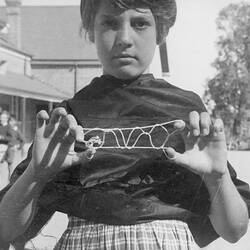Summary
Used: circa 1989
Donated by the Embassy of the Republic of South Korea, 1989.
The Australian Children's Folklore Collection is unique in Australia, documenting contemporary children's folklore across Australia and in other countries reaching back to the 1870s. The Collection has a strong component of research material relating to Victoria.
Kites have been flown in the East since before recorded history. Eastern kites have legendary and historical associations, expressed in their traditional shapes, names and decorations. Kite-fighting is popular in many countries. The string is coated with glue and powdered glass or porcelain, which makes the string stiff and extremely sharp. When two kite-strings touch, one person jerks the string and it cuts through the other's kite string. Kites are a favourite pastime of both children and adults. Kite-flying in the republic of Korea is associated with a number of legends. sometimes it is also competitive, either by flying the highest or by coating the string with glass dust to cut the string of an opponent's kite. This object is a typical example of a traditional Korean kite reel.
Physical Description
Korean wooden kite reel with thin twine wrapped around the outside. Reel is lacquered natural wood with six spokes. Each spoke has three pieces of wood attaching it to the others and forming a hub in the middle, and a rounded end-piece, around which the twine is wrapped. A dowel handle runs through the length of the hub and extends beyond it for 41cm. It is attached at the reel end by a metal fastening. The twine is made from nylon, and the surface is coated in a substance, possibly glass, which gives it a rasp-like feel. The twine is quite stiff. Acknowledgement: Australian Children's Folklore Collection, Museum Victoria.
More Information
-
Collection Names
-
Collecting Areas
Leisure, Home & Community, Childhood, Migration & Cultural Diversity
-
Acquisition Information
Cultural Gifts Donation from Dr June Factor, 18 May 1999
-
Acknowledgement
Donated through the Australian Government's Cultural Gifts Program.
-
Place & Date Made
-
Classification
-
Category
-
Discipline
-
Type of item
-
overall dimensions
23.5 cm (Length), 23.5 cm (Width), 69 cm (Height)
-
References
Toys and Games of Children of the World; Gabriel Chanan and Hazel Francis, pub. UNESCO, 1984.
-
Keywords
Children's Play, Cultural Traditions, Handmade Games & Toys, Wind, Making History - Australian Childrens Folklore
